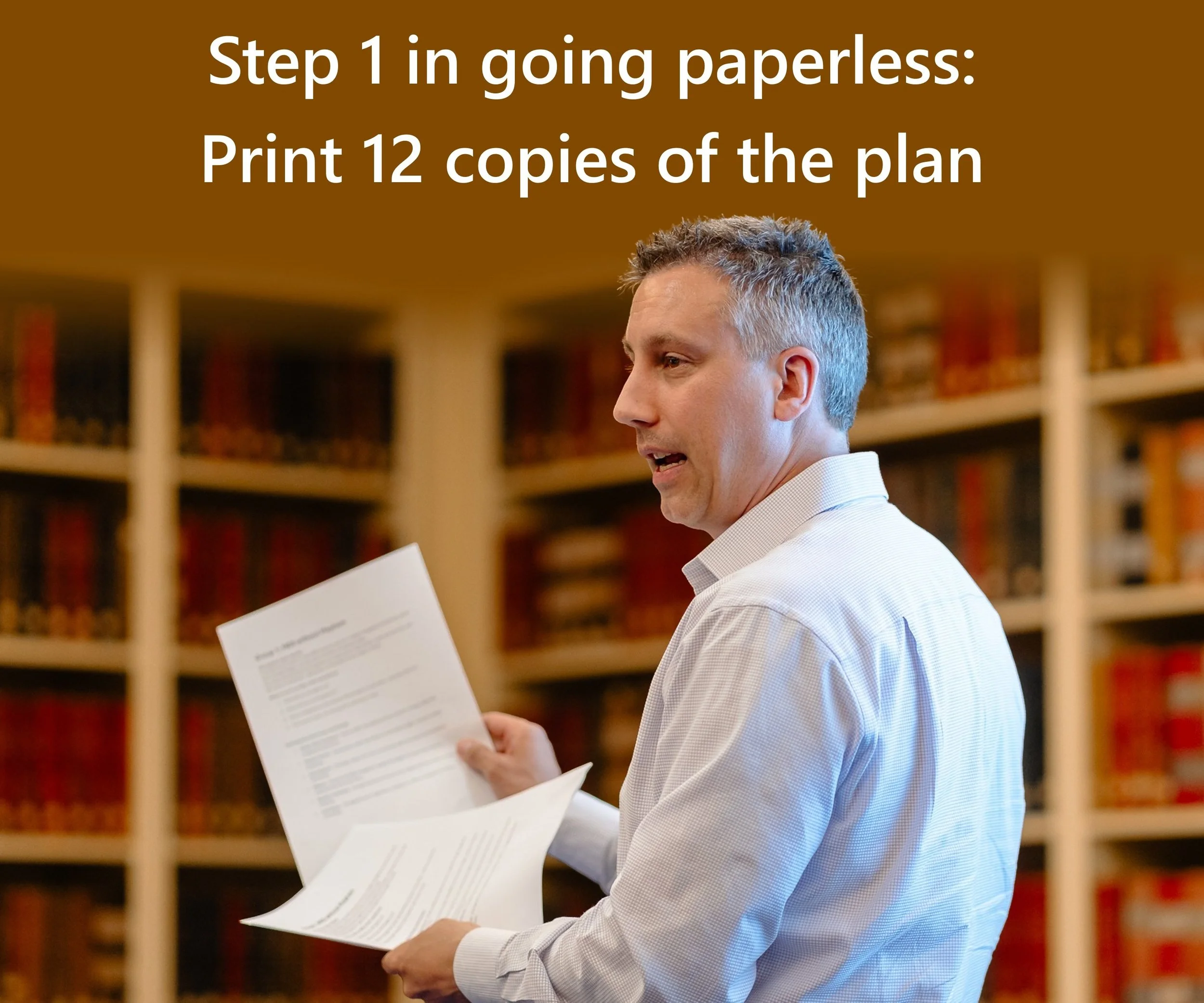Paper Thinking in a Digital World
I like to physically hold my digital strategy. There’s just something reassuring about it.
I mean… how else am I supposed to know it’s real?
There’s a special kind of satisfaction that comes from printing your paperless plan twelve times, color-coding it, stapling it, and placing it in a binder labeled “Digital Future – Confidential.” Bonus points if it’s laminated. Triple bonus if someone wheels it into a meeting room like it’s carrying nuclear codes.
We laugh, but this happens more than we’d like to admit.
We want digital transformation, but we still seek comfort in what we can touch, stack, staple, and shelve. Because paper feels safe. Paper feels finished.
Digital? That’s a different story.
The Problem Isn’t the Paper, It’s What We’re Trying to Preserve
Paper is easy. It’s static. It gives the illusion that something is complete. When you print it, it’s done. When you hand it out, you feel like you’ve made progress. That illusion is powerful, especially in organizations where complexity is high and certainty is scarce.
But transformation is messy. It’s uncomfortable. It forces people to work differently, not just with different tools.
So when we wrap transformation in binders and PDFs and call it strategy, we’re often avoiding the real work. Instead of questioning how work should be done, we’re digitizing what’s already familiar. Instead of challenging old habits, we’re immortalizing them in sleek new platforms.
You can’t create a dynamic, adaptive organization with laminated thinking.
Digitizing your forms, putting your playbooks in SharePoint, and routing your approvals through a portal isn’t transformation. It’s digitized bureaucracy. And when you digitize outdated processes, all you’re doing is adding friction faster.
The real goal isn’t to eliminate paper, it’s to eliminate paper thinking: the idea that progress must be documented, stacked, and archived to be real. But in today’s world, the most valuable work is dynamic, collaborative, and often invisible on paper.
Behavior Is the Backbone of Digital Success
Here’s where the real work begins, and where most transformation efforts quietly stall.
You can deploy a dozen tools, spin up a dozen workflows, and send out a dozen emails with bold declarations like “Our Digital Journey Starts Now.” But if the way people think, act, and collaborate doesn’t change? You’re just spending money on new ways to do the same old work.
Behavior is everything.
Think about how meetings work in many companies. If someone doesn’t print the agenda, is the meeting even happening? If the decision isn’t documented in a follow-up email, does it count? If the strategy hasn’t been turned into a PowerPoint, has it even been approved?
These rituals are comforting, but they’re not effective. They were built for a slower, more hierarchical world. A world where knowledge lived in silos and workflows relied on physical handoffs.
Now, we need people to co-create in real time. To adapt when conditions change. To access shared knowledge instantly and make decisions without needing to loop in five approvers from three departments. That requires more than training people to use new software. It requires re-training how they think about value, ownership, and trust.
The real power of digital isn’t in the tech—it’s in what the tech enables. Speed. Visibility. Autonomy. But those benefits only show up when people are empowered to use the tools in a different way than they used paper.
That’s where most transformations fall short. The tech goes live, the dashboards get built, and the executive team celebrates. But six months later, people are still working in old ways, holding meetings to summarize data that’s already visible in real time, exporting reports so they can reformat them in Excel, or clicking through automated workflows that still require five manual checks along the way.
We don’t need more tools. We need new behaviors.
Because when people don’t change, the outcomes don’t either.
Start by Asking Better Questions
Digital transformation isn’t about installing the newest platform. It’s about having the courage to ask the right questions before the rollout even begins.
Are we truly redesigning how work gets done, or just replicating it on a screen?
Are we measuring success by usage, or by impact?
Have we actually trained people to think and work differently, or just walked them through the software tutorial?
You don’t build a digital organization by digitizing documents. You build it by shifting mindsets. That means removing the approval steps that no longer make sense. It means streamlining handoffs, enabling faster decisions, and trusting people to act without waiting for formal documentation.
It means letting go of the belief that you need to hold something in your hands for it to be real.

